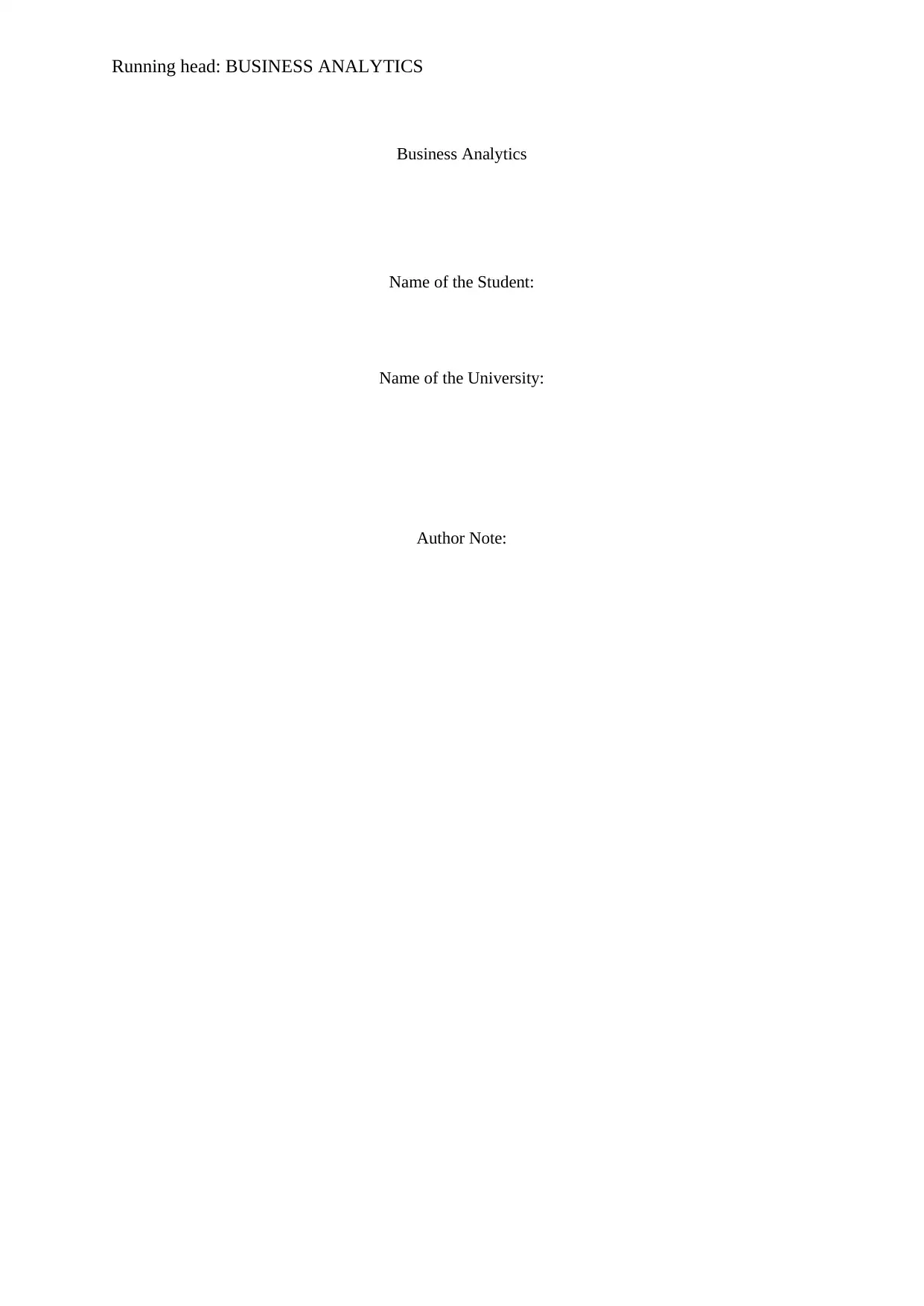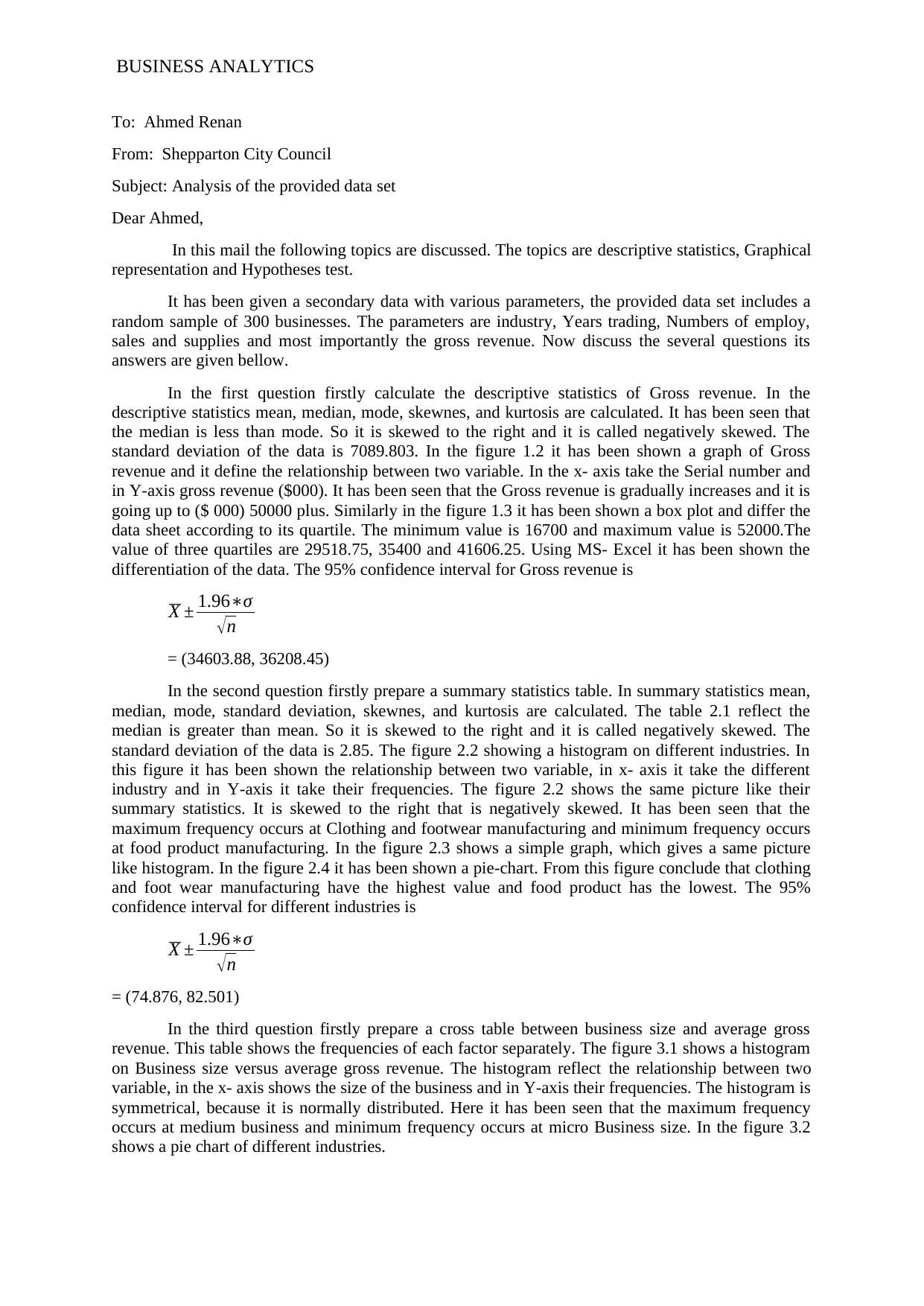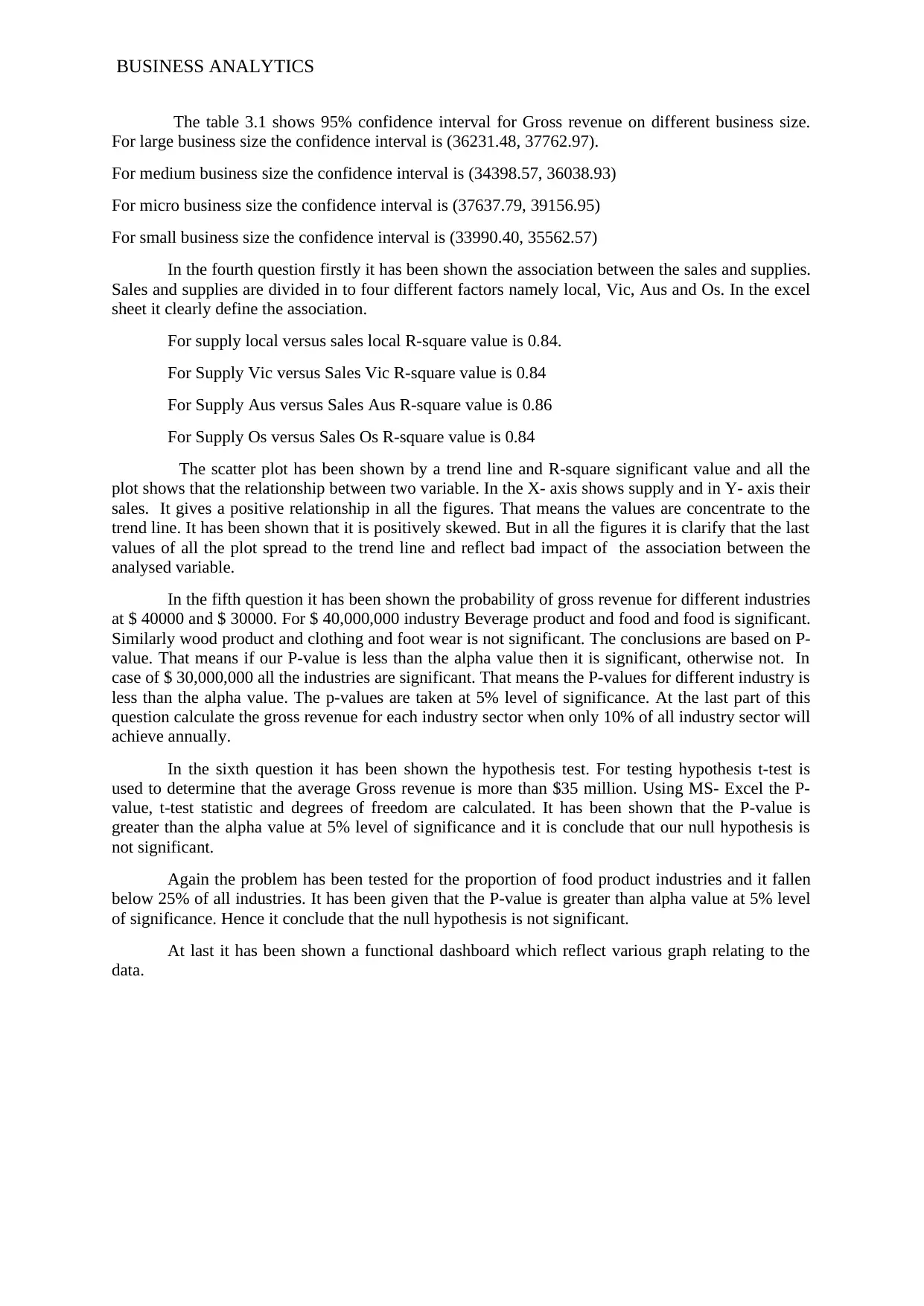Deakin University MIS171 Business Analytics Report: Analysis
VerifiedAdded on 2022/09/14
|3
|1188
|11
Report
AI Summary
This report presents a comprehensive analysis of a business dataset, focusing on various aspects of business analytics. The analysis includes the calculation of descriptive statistics (mean, median, mode, skewness, kurtosis) for gross revenue, along with graphical representations like histograms and box plots. The report explores the relationship between different variables, such as industry and revenue, business size and revenue, and sales and supplies. It also includes hypothesis testing to determine the significance of certain factors, such as whether the average gross revenue exceeds a certain threshold, and the probability of gross revenue for different industries. The analysis uses tools like MS-Excel to generate tables, graphs, and confidence intervals, providing insights into the data and drawing conclusions based on statistical findings. The report also includes a functional dashboard reflecting various graphs related to the data, and the assignment is based on the MIS171 assessment from Deakin University.

Running head: BUSINESS ANALYTICS
Business Analytics
Name of the Student:
Name of the University:
Author Note:
Business Analytics
Name of the Student:
Name of the University:
Author Note:
Paraphrase This Document
Need a fresh take? Get an instant paraphrase of this document with our AI Paraphraser

BUSINESS ANALYTICS
To: Ahmed Renan
From: Shepparton City Council
Subject: Analysis of the provided data set
Dear Ahmed,
In this mail the following topics are discussed. The topics are descriptive statistics, Graphical
representation and Hypotheses test.
It has been given a secondary data with various parameters, the provided data set includes a
random sample of 300 businesses. The parameters are industry, Years trading, Numbers of employ,
sales and supplies and most importantly the gross revenue. Now discuss the several questions its
answers are given bellow.
In the first question firstly calculate the descriptive statistics of Gross revenue. In the
descriptive statistics mean, median, mode, skewnes, and kurtosis are calculated. It has been seen that
the median is less than mode. So it is skewed to the right and it is called negatively skewed. The
standard deviation of the data is 7089.803. In the figure 1.2 it has been shown a graph of Gross
revenue and it define the relationship between two variable. In the x- axis take the Serial number and
in Y-axis gross revenue ($000). It has been seen that the Gross revenue is gradually increases and it is
going up to ($ 000) 50000 plus. Similarly in the figure 1.3 it has been shown a box plot and differ the
data sheet according to its quartile. The minimum value is 16700 and maximum value is 52000.The
value of three quartiles are 29518.75, 35400 and 41606.25. Using MS- Excel it has been shown the
differentiation of the data. The 95% confidence interval for Gross revenue is
X ± 1.96∗σ
√n
= (34603.88, 36208.45)
In the second question firstly prepare a summary statistics table. In summary statistics mean,
median, mode, standard deviation, skewnes, and kurtosis are calculated. The table 2.1 reflect the
median is greater than mean. So it is skewed to the right and it is called negatively skewed. The
standard deviation of the data is 2.85. The figure 2.2 showing a histogram on different industries. In
this figure it has been shown the relationship between two variable, in x- axis it take the different
industry and in Y-axis it take their frequencies. The figure 2.2 shows the same picture like their
summary statistics. It is skewed to the right that is negatively skewed. It has been seen that the
maximum frequency occurs at Clothing and footwear manufacturing and minimum frequency occurs
at food product manufacturing. In the figure 2.3 shows a simple graph, which gives a same picture
like histogram. In the figure 2.4 it has been shown a pie-chart. From this figure conclude that clothing
and foot wear manufacturing have the highest value and food product has the lowest. The 95%
confidence interval for different industries is
X ± 1.96∗σ
√n
= (74.876, 82.501)
In the third question firstly prepare a cross table between business size and average gross
revenue. This table shows the frequencies of each factor separately. The figure 3.1 shows a histogram
on Business size versus average gross revenue. The histogram reflect the relationship between two
variable, in the x- axis shows the size of the business and in Y-axis their frequencies. The histogram is
symmetrical, because it is normally distributed. Here it has been seen that the maximum frequency
occurs at medium business and minimum frequency occurs at micro Business size. In the figure 3.2
shows a pie chart of different industries.
To: Ahmed Renan
From: Shepparton City Council
Subject: Analysis of the provided data set
Dear Ahmed,
In this mail the following topics are discussed. The topics are descriptive statistics, Graphical
representation and Hypotheses test.
It has been given a secondary data with various parameters, the provided data set includes a
random sample of 300 businesses. The parameters are industry, Years trading, Numbers of employ,
sales and supplies and most importantly the gross revenue. Now discuss the several questions its
answers are given bellow.
In the first question firstly calculate the descriptive statistics of Gross revenue. In the
descriptive statistics mean, median, mode, skewnes, and kurtosis are calculated. It has been seen that
the median is less than mode. So it is skewed to the right and it is called negatively skewed. The
standard deviation of the data is 7089.803. In the figure 1.2 it has been shown a graph of Gross
revenue and it define the relationship between two variable. In the x- axis take the Serial number and
in Y-axis gross revenue ($000). It has been seen that the Gross revenue is gradually increases and it is
going up to ($ 000) 50000 plus. Similarly in the figure 1.3 it has been shown a box plot and differ the
data sheet according to its quartile. The minimum value is 16700 and maximum value is 52000.The
value of three quartiles are 29518.75, 35400 and 41606.25. Using MS- Excel it has been shown the
differentiation of the data. The 95% confidence interval for Gross revenue is
X ± 1.96∗σ
√n
= (34603.88, 36208.45)
In the second question firstly prepare a summary statistics table. In summary statistics mean,
median, mode, standard deviation, skewnes, and kurtosis are calculated. The table 2.1 reflect the
median is greater than mean. So it is skewed to the right and it is called negatively skewed. The
standard deviation of the data is 2.85. The figure 2.2 showing a histogram on different industries. In
this figure it has been shown the relationship between two variable, in x- axis it take the different
industry and in Y-axis it take their frequencies. The figure 2.2 shows the same picture like their
summary statistics. It is skewed to the right that is negatively skewed. It has been seen that the
maximum frequency occurs at Clothing and footwear manufacturing and minimum frequency occurs
at food product manufacturing. In the figure 2.3 shows a simple graph, which gives a same picture
like histogram. In the figure 2.4 it has been shown a pie-chart. From this figure conclude that clothing
and foot wear manufacturing have the highest value and food product has the lowest. The 95%
confidence interval for different industries is
X ± 1.96∗σ
√n
= (74.876, 82.501)
In the third question firstly prepare a cross table between business size and average gross
revenue. This table shows the frequencies of each factor separately. The figure 3.1 shows a histogram
on Business size versus average gross revenue. The histogram reflect the relationship between two
variable, in the x- axis shows the size of the business and in Y-axis their frequencies. The histogram is
symmetrical, because it is normally distributed. Here it has been seen that the maximum frequency
occurs at medium business and minimum frequency occurs at micro Business size. In the figure 3.2
shows a pie chart of different industries.

BUSINESS ANALYTICS
The table 3.1 shows 95% confidence interval for Gross revenue on different business size.
For large business size the confidence interval is (36231.48, 37762.97).
For medium business size the confidence interval is (34398.57, 36038.93)
For micro business size the confidence interval is (37637.79, 39156.95)
For small business size the confidence interval is (33990.40, 35562.57)
In the fourth question firstly it has been shown the association between the sales and supplies.
Sales and supplies are divided in to four different factors namely local, Vic, Aus and Os. In the excel
sheet it clearly define the association.
For supply local versus sales local R-square value is 0.84.
For Supply Vic versus Sales Vic R-square value is 0.84
For Supply Aus versus Sales Aus R-square value is 0.86
For Supply Os versus Sales Os R-square value is 0.84
The scatter plot has been shown by a trend line and R-square significant value and all the
plot shows that the relationship between two variable. In the X- axis shows supply and in Y- axis their
sales. It gives a positive relationship in all the figures. That means the values are concentrate to the
trend line. It has been shown that it is positively skewed. But in all the figures it is clarify that the last
values of all the plot spread to the trend line and reflect bad impact of the association between the
analysed variable.
In the fifth question it has been shown the probability of gross revenue for different industries
at $ 40000 and $ 30000. For $ 40,000,000 industry Beverage product and food and food is significant.
Similarly wood product and clothing and foot wear is not significant. The conclusions are based on P-
value. That means if our P-value is less than the alpha value then it is significant, otherwise not. In
case of $ 30,000,000 all the industries are significant. That means the P-values for different industry is
less than the alpha value. The p-values are taken at 5% level of significance. At the last part of this
question calculate the gross revenue for each industry sector when only 10% of all industry sector will
achieve annually.
In the sixth question it has been shown the hypothesis test. For testing hypothesis t-test is
used to determine that the average Gross revenue is more than $35 million. Using MS- Excel the P-
value, t-test statistic and degrees of freedom are calculated. It has been shown that the P-value is
greater than the alpha value at 5% level of significance and it is conclude that our null hypothesis is
not significant.
Again the problem has been tested for the proportion of food product industries and it fallen
below 25% of all industries. It has been given that the P-value is greater than alpha value at 5% level
of significance. Hence it conclude that the null hypothesis is not significant.
At last it has been shown a functional dashboard which reflect various graph relating to the
data.
The table 3.1 shows 95% confidence interval for Gross revenue on different business size.
For large business size the confidence interval is (36231.48, 37762.97).
For medium business size the confidence interval is (34398.57, 36038.93)
For micro business size the confidence interval is (37637.79, 39156.95)
For small business size the confidence interval is (33990.40, 35562.57)
In the fourth question firstly it has been shown the association between the sales and supplies.
Sales and supplies are divided in to four different factors namely local, Vic, Aus and Os. In the excel
sheet it clearly define the association.
For supply local versus sales local R-square value is 0.84.
For Supply Vic versus Sales Vic R-square value is 0.84
For Supply Aus versus Sales Aus R-square value is 0.86
For Supply Os versus Sales Os R-square value is 0.84
The scatter plot has been shown by a trend line and R-square significant value and all the
plot shows that the relationship between two variable. In the X- axis shows supply and in Y- axis their
sales. It gives a positive relationship in all the figures. That means the values are concentrate to the
trend line. It has been shown that it is positively skewed. But in all the figures it is clarify that the last
values of all the plot spread to the trend line and reflect bad impact of the association between the
analysed variable.
In the fifth question it has been shown the probability of gross revenue for different industries
at $ 40000 and $ 30000. For $ 40,000,000 industry Beverage product and food and food is significant.
Similarly wood product and clothing and foot wear is not significant. The conclusions are based on P-
value. That means if our P-value is less than the alpha value then it is significant, otherwise not. In
case of $ 30,000,000 all the industries are significant. That means the P-values for different industry is
less than the alpha value. The p-values are taken at 5% level of significance. At the last part of this
question calculate the gross revenue for each industry sector when only 10% of all industry sector will
achieve annually.
In the sixth question it has been shown the hypothesis test. For testing hypothesis t-test is
used to determine that the average Gross revenue is more than $35 million. Using MS- Excel the P-
value, t-test statistic and degrees of freedom are calculated. It has been shown that the P-value is
greater than the alpha value at 5% level of significance and it is conclude that our null hypothesis is
not significant.
Again the problem has been tested for the proportion of food product industries and it fallen
below 25% of all industries. It has been given that the P-value is greater than alpha value at 5% level
of significance. Hence it conclude that the null hypothesis is not significant.
At last it has been shown a functional dashboard which reflect various graph relating to the
data.
⊘ This is a preview!⊘
Do you want full access?
Subscribe today to unlock all pages.

Trusted by 1+ million students worldwide
1 out of 3
Related Documents
Your All-in-One AI-Powered Toolkit for Academic Success.
+13062052269
info@desklib.com
Available 24*7 on WhatsApp / Email
![[object Object]](/_next/static/media/star-bottom.7253800d.svg)
Unlock your academic potential
Copyright © 2020–2025 A2Z Services. All Rights Reserved. Developed and managed by ZUCOL.





